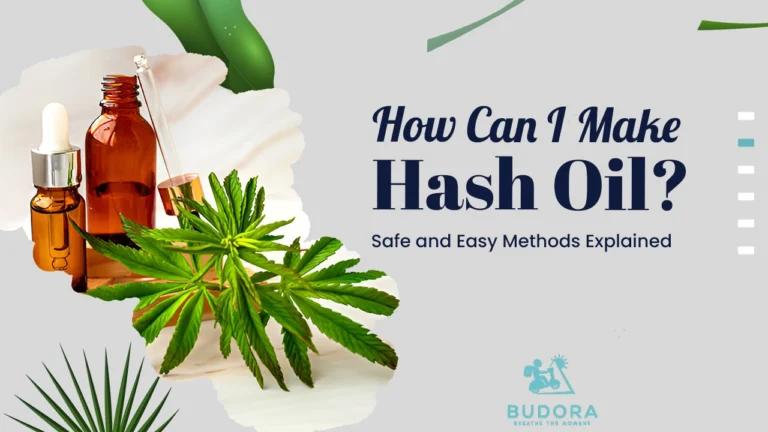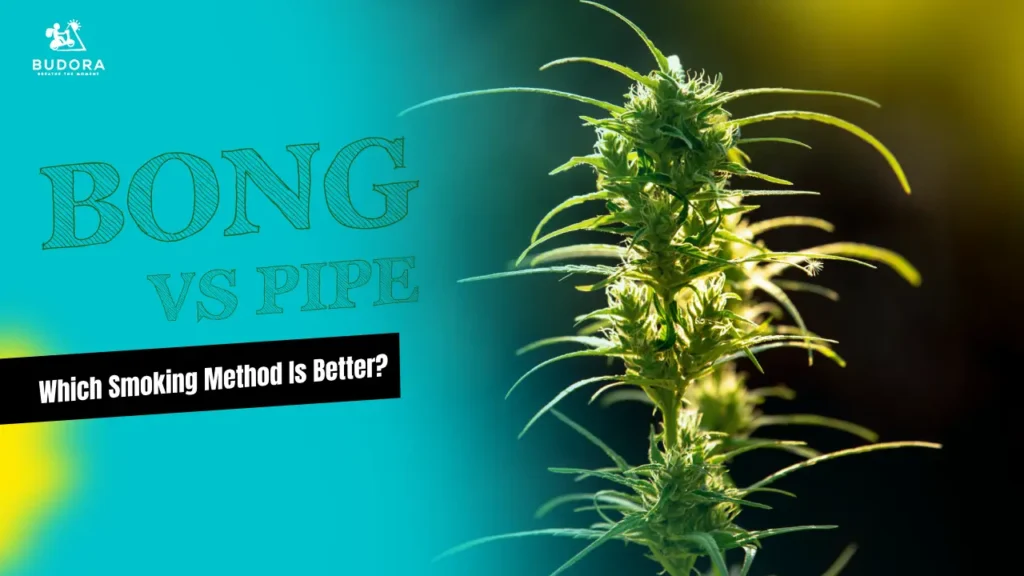Blog
How Can I Make Hash Oil? Safe and Easy Methods Explained
- Budora Team
- Concentrates WeedBlogs


Have you ever found yourself staring at a cannabis plant, wondering how you can make cannabis concentrates like hash oil and unlock its full potential without spending too much at the dispensary? You’re not alone.
Whether you’re a cannabis enthusiast looking to make your own oil or you’re just curious, this guide will show you the easy way to make hash oil right at home!
Key Points
- If you want strong, flavorful cannabis concentrates, it really helps to start with good-quality weed or clean kief—stuff that’s sticky and full of resin works best. When it comes to making the oil, there are a few ways to go about it.
- Alcohol extraction (like QWISO and Ethanol) is great for beginners (but requires careful solvent evaporation), butane makes super potent oil (though it’s very risky), and rosin pressing is a clean, solvent-free method.
- If you’re using alcohol, make sure it’s food-grade, like Everclear or pure ethanol. It’s much safer and easier to evaporate completely. Remember that alcohol is flammable and should be used in a well-ventilated area away from open flames.
- Once you’ve extracted the oil, don’t skip the purging step—it’s key to removing any leftover solvents so the final product is safe and smooth.
- And when you’re done, store your hash oil in a small, airtight glass container or silicone jar. Keep it in a cool, dark spot so it stays fresh and keeps its strength over time.
How Can I Make Hash Oil?
Making hash oil is easier than you might think. There are several methods you can try, and we’re going to walk you through the simplest ways to make it. Whether you’re a beginner or an experienced cannabis user, these methods can be done at home with minimal equipment. Just remember, safety and patience are key to getting the best results. You can find the all the aspects of the subject in depth.
How Can I Make Hash Oil?
Making hash oil is easier than you might think. There are several methods you can try, and we’re going to walk you through the simplest ways to make it.
1. The QWISO Method (Using Isopropyl Alcohol)
This is one of the most popular and easiest ways for beginners to make hash oil. Here’s how you do it:
What You’ll Need:
- Dried cannabis (buds or trim)
- High-purity rubbing alcohol (90% or higher)
- A mason jar
- A coffee filter
- A glass dish
- A razor blade
Steps:
- Freeze the cannabis and alcohol overnight.
- Shake the cannabis and alcohol together in the jar for about 30 seconds. Shaking too vigorously can result in a greener, more bitter oil.
- Strain the mixture through a coffee filter into a glass dish.
- Let the alcohol evaporate in a well-ventilated area away from any ignition sources. You can speed this up by using gentle heat (like a warm water bath), but avoid direct heat.
- Scrape the remaining oil with the razor blade. This method is super simple and gives you a clean, potent oil. Just make sure you don’t shake it too much, or your hash oil may turn green and bitter.
Pros:
- Simple for beginners, it can yield potent oil.
Cons:
- Uses a solvent (isopropyl alcohol) that requires thorough evaporation. Isopropyl alcohol is flammable; use in a well-ventilated area away from open flames.
- This method is super simple and gives you a clean, potent oil. Just make sure you don’t shake it too much, or your hash oil may turn green and bitter.
2. The BHO Method (Using Butane)
Note: The BHO method is powerful but not recommended for beginners due to safety concerns. It requires using butane and special equipment. This method is typically used for creating shatter or other types of cannabis concentrates.
Pros:
- Can produce very potent cannabis concentrates like shatter and wax.
Cons:
- Extremely dangerous for beginners due to the high risk of explosion and fire. Requires specialized equipment and should only be performed by experienced individuals in well-ventilated areas away from all ignition sources.
3. The Rosin Method (No Solvents)
If you’re looking for a safe and simple way to make hash oil without using chemicals, the rosin press method is the way to go.
What You’ll Need:
- Cannabis buds
- Parchment paper
- A hair straightener (or a rosin press if you have one)
- A small scraper
Steps:
- Place the cannabis between two sheets of parchment paper.
- Press the cannabis with a hot hair straightener for about 5–10 seconds.
- You’ll see the oil start to come out—scrape it up with the scraper. This method is great for beginners because it’s quick and doesn’t involve any dangerous solvents.
Pros:
- Solvent-free, safe, and easy for beginners, with quick results.
Cons:
- Yield might be lower compared to solvent-based methods.
- This method is great for beginners because it’s quick and doesn’t involve any dangerous solvents.
4. The CO2 Method (Super Clean, But Expensive)
This method uses pressurized carbon dioxide (CO2) to extract the oils from cannabis. It’s a bit more technical and requires specialized equipment, but it’s one of the cleanest methods for producing high-quality cannabis concentrates. The process extracts the cannabinoids and terpenes without using solvents, resulting in pure, potent oil.
You’ll need
- O2 extraction machine (expensive)
- Cannabis, the CO2 method is popular in commercial settings because it preserves the flavor and potency of the cannabis while avoiding harsh chemicals.
Pros:
- Produces very pure and potent cannabis concentrates, preserves terpenes, and avoids harsh chemicals.
Cons:
- Requires expensive and specialized equipment, not feasible for home use.
- The CO2 method is popular in commercial settings because it preserves the flavor and potency of the cannabis while avoiding harsh chemicals.
5. The Ethanol Method (Alcohol Extraction)
Similar to QWISO, but in this method, ethanol is used instead of isopropyl alcohol. Ethanol is considered a safer alternative for making hash oil, and it’s often used in commercial extractions.
You’ll need
- Ethanol (preferably food-grade)
- Cannabis
- Glass jar
- Coffee filter or cheesecloth
- Glass dish
Steps
- Freeze the cannabis and ethanol for a few hours.
- Soak the cannabis in the ethanol for about 5–10 minutes, stirring occasionally.
- Strain the mixture through a coffee filter or cheesecloth.
- Evaporate the ethanol in a well-ventilated area.
Pros:
- Ethanol can produce high-quality cannabis concentrates, Ethanol is considered a safer solvent than isopropyl alcohol for some applications.
Cons:
- Requires careful evaporation of ethanol, which is flammable.
- This method produces high-quality oil, but you’ll need to be careful about fully evaporating the ethanol.
6. The Ice Water Hash (Bubble Hash Method)
The ice water method is another way to extract hash oil, though it’s more labor-intensive and doesn’t involve oils directly. It focuses on separating the trichomes from the cannabis plant using ice water, then pressing the hash into a resin-like concentrate.
You’ll need
- Ice
- Water
- Cannabis
- Bubble bags (or mesh bags)
- Large container
Steps
- Fill a container with ice and water.
- Add your cannabis and agitate it to break off the trichomes.
- Strain the mixture through the bubble bags.
- Let the water drain, and then press the collected trichomes into hash. While this method doesn’t produce liquid oil directly, it creates hash that can be further processed into hash oil.
Pros:
- Solvent-free method for creating a potent concentrate (bubble hash) that can be further processed.
Cons:
- More labor-intensive, doesn’t directly produce liquid oil.
- While this method doesn’t produce liquid oil directly, it creates hash that can be further processed into hash oil.
7. The Dry Sift Method (Solvent-Free, Simple)
The dry sift method is a non-solvent method for making hash oil that involves separating the trichomes from the cannabis using dry, mechanical methods. It’s one of the oldest methods of extraction and is perfect for making high-quality concentrates without any chemicals.
You’ll need
- Cannabis
- Sifting screens (or a kief box)
Steps
- Gently break apart the cannabis and place it on the sifting screen.
- Shake the screen to separate the trichomes from the plant material.
- Collect the sifted kief (the fine powder).
- Compress it into a solid form to make hash. The resulting hash can be further processed to create oil, but this is a very hands-on, solvent-free approach.
Pros:
- Solvent-free, simple, and a traditional method for making high-quality kief/hash.
Cons:
- Doesn’t directly produce liquid oil; the yield can vary.
- The resulting hash can be further processed to create oil, but this is a very hands-on, solvent-free approach.
How to Store Hash Oil
- Use a small, airtight glass container or silicone jar.
- Keep it in a cool, dark place to prevent degradation.
- Avoid exposing the oil to heat or light, as these factors can reduce its potency over time.
How to Use Hash Oil
Now that you’ve learned how to make hash oil, you’re probably wondering, “How do I use it?”
There are many ways to enjoy hash oil:
- Smoke it by adding it to a joint or pipe.
- Vape it with a compatible vape pen or cartridge.
- Dab it with a dab rig for a super strong hit.
- Cook with hash oil—you can mix it into butter or oil for edibles. Remember to decarboxylate your hash oil before using it in edibles to activate the THC.
If you’re new to hash oil, start with a very small amount. It’s much stronger than regular cannabis, so you don’t want to go overboard.
What Types of Hash Oil Can I Make?
There are a few different types of cannabis concentrates you can make. Some of the most popular include:
- Shatter: A hard, glass-like cannabis extract.
- Wax/Budder: Soft and creamy oil that’s easy to work with.
- Live Resin: Made from fresh cannabis, giving it a more robust flavor.
- Rosin: Made by pressing cannabis with heat, no chemicals involved.
Benefits of Hash Oil
- High Potency: Contains higher levels of THC or CBD, offering a stronger effect with a smaller dose.
- Versatility: Can be smoked, vaporized, or used in edibles, tinctures, and topicals.
- Fast-Acting: Provides quick relief, ideal for medicinal use.
- Rich in Terpenes: Offers enhanced flavors and therapeutic benefits due to natural cannabis terpenes.
Why Make Hash Oil at Home?
There are several reasons why you might want to learn how to make hash oil:
- Cost-saving – Buying hash oil from the store can be expensive, and making it at home can save you money.
- Complete control – You decide exactly what goes into your oil.
- Fun and educational – Learning about making hash oil is a great way to explore cannabis and discover the different types of oil that can be made.
Potential Side Effects of Hash Oil
- Overconsumption: Can lead to dizziness, anxiety, or paranoia. Start with a small dose.
- Impaired Coordination: May impair motor skills and cognitive function. Avoid driving or operating machinery.
- Dry Mouth & Red Eyes: Common side effects; stay hydrated and use eye drops if necessary.
- Risk of Addiction: Regular use can lead to dependency. Take breaks when needed.
- Respiratory Issues: Smoking or vaping may irritate the lungs. Consider alternative consumption methods if you have lung conditions.
Risks and Precautions: Be Safe While Making Hash Oil
While making hash oil can be a fun and rewarding experience, it’s essential to follow some safety precautions:
- Work in a Ventilated Area: Whether you’re using isopropyl alcohol or butane, make sure you’re working in a well-ventilated area to avoid inhaling fumes.
- Wear Protective Gear: For methods that involve butane, always wear gloves and safety glasses to prevent accidents.
- Avoid Open Flames: Butane and alcohol are highly flammable, so make sure there are no flames, sparks, or heat sources nearby. This includes pilot lights on stoves or water heaters.
Legal Considerations of Hash Oil
- Cannabis Legislation: Check local laws to ensure cannabis extracts are legal in your area.
- Home Extraction Laws: Extracting hash oil at home may be illegal in some places, even if possessing it is not.
- Purchase of Materials: Some materials (like butane or ethanol) may be regulated or restricted for cannabis extraction in certain locations.
Conclusion
Now that you know how to make hash oil, it’s time to get started. Whether you’re using the simple rosin press method or another technique, making hash oil is fun and rewarding. Plus, it gives you complete control over the quality and strength of your oil. Remember to stay safe, follow local laws, and start small. Once you get the hang of it, you’ll be making your premium hash oil in no time!
FAQs
What’s the best way to make hash oil for beginners?
Can I use trim instead of buds?
How much cannabis do I need to make hash oil?
How long does hash oil last?
Can I cook with hash oil?
Like this article?

Budora Team
OTHER ARTICLES YOU MAY LIKE




